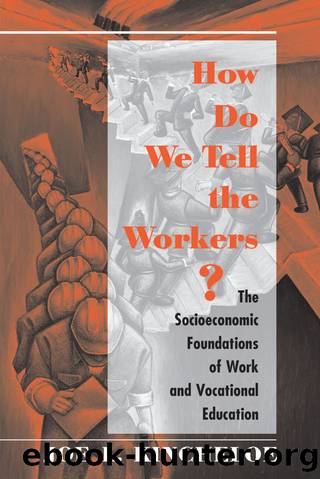How Do We Tell The Workers? by Joe Kincheloe

Author:Joe Kincheloe [Kincheloe, Joe]
Language: eng
Format: epub
Tags: Social Science, General, Sociology
ISBN: 9780429973345
Google: YVJPDwAAQBAJ
Publisher: Routledge
Published: 2018-03-05T04:42:33+00:00
Desperately Seeking Mobility
By 2010, two out of five Americans will be nonwhite. Since racial and ethnic minorities are more than twice as likely to live below the poverty line, dramatic consequences accompany such demographics. By 2050, one out of every two Americans will be nonwhite. In the twenty-first century, four out of five new workers will be women, nonwhites, or new immigrants. Virtually nothing is being done to prepare for these eventualities. In late-twentieth-century America, the marginalized have few friends and are divided among themselves. White men are told that they are privilegedâand relative to other demographic groups, they are. But to working-class or poor white men, the label of "privileged" seems like a dirty joke, as they hang precariously over the edge of poverty. In such circumstances, many of them feel threatened when minorities or women gain access to formerly all-white-male terrain. Failing to understand questions of mobility in macrosociological context, white men blame the victims of an inegalitarian system. The possibility of working-class solidarity or a unified challenge to the greedy is thus subverted (Banfield, 1991; Wolfe, 1991; Rubin, 1994).
It has been hard for Americans, for working-class Americans in particular, to grasp the nature and meaning of the disintegration of Fordism after 1973. For young people from poor families, it means that the American ideal of universal upward mobility is a cruel irony (West, 1993), As Peter McLaren (1986) and Jay MacLeod (1987) have so clearly pointed out, the American social ladder is not as easy to climb as we thought. Young people from the lower half of the class structure feel so ensnared in the net of poverty that upward aspirations seem an indulgence. Working-class Americans have traditionally harbored the hope of "moving up"âif not themselves, then for their children. Maybe the hope was always greater than the possibility, but it persisted nonetheless. Poor and immigrant parents dedicated to the possibility of a better life for their children did the "dirty work" so sons and daughters could do the "clean work." The promise of upward mobility was a tangible realityâand it shaped American lives. Indeed, the belief shaped America itself (Rubin, 1994).
The post-Fordist era, the last quarter of the twentieth century, has not been kind to America's young people. Their economic hardship is especially bitter and discouraging, coming as it does after a dream of financial security and upward mobility. They entered vocational programs on the assumption that they were being prepared for economic prosperity in their adulthood. In their late twenties, many of these men and women still have the jobs they obtained in high school. With such prospects, it is not surprising that many males and some females from poor families have found gang and gangrelated activity attractive. Nothing speaks more directly to the breakdown of the hope of social mobility than the rise of gangs over the last fifteen years in large and small urban areas. America's poor and minority youth face tremendous obstacles to social mobility but few barriers to gang involvement and the financial rewards such organizations offer.
Download
This site does not store any files on its server. We only index and link to content provided by other sites. Please contact the content providers to delete copyright contents if any and email us, we'll remove relevant links or contents immediately.
| Business School Guides | GMAT |
| Guides | Interviewing |
| Job Hunting | Job Markets & Advice |
| Resumes | Vocational Guidance |
| Volunteer Work |
The Motivation Myth by Jeff Haden(5158)
Audition by Ryu Murakami(4851)
Adulting by Kelly Williams Brown(4488)
The Confidence Code by Katty Kay(4189)
A Mind For Numbers: How to Excel at Math and Science (Even If You Flunked Algebra) by Barbara Oakley(3222)
Waiting in the Wings by Melissa Brayden(3181)
Self-Esteem by Matthew McKay & Patrick Fanning(3093)
Fooled by Randomness: The Hidden Role of Chance in Life and in the Markets by Nassim Nicholas Taleb(3048)
The ONE Thing by Gary Keller(3010)
Nice Girls Don't Get the Corner Office by Lois P. Frankel(2997)
The Dictionary of Body Language by Joe Navarro(2947)
How to be More Interesting by Edward De Bono(2748)
Designing Your Life by Bill Burnett(2667)
Getting Things Done by David Allen(2646)
The Plant Paradox by Dr. Steven R. Gundry M.D(2548)
Police Exams Prep 2018-2019 by Kaplan Test Prep(2488)
What Color Is Your Parachute? 2015 by Richard N. Bolles(2264)
Dangerous Personalities by Joe Navarro(2234)
When to Jump by Mike Lewis(2204)
